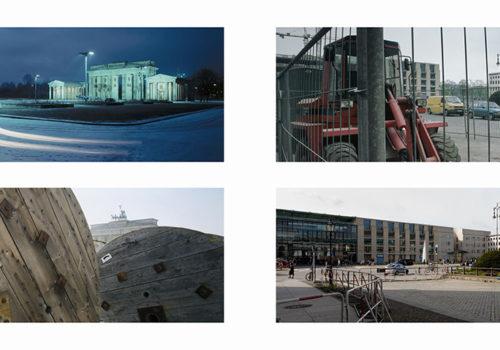The Berlin institution offers a unique look at Berlin and Germany: landscape photographs taken between 1966 and 2023 by German photographer Michael Ruetz who dedicated his life to capturing the effects of time on the horizon.
Michael Ruetz (Berlin, 1940) has, through his practice, witnessed the urban and social changes of a Germany battered by History and of a city, Berlin, whose identity has been shaped by the reunification. An archival work – which could be described as of general interest – spanning seven decades and made up of nearly 600 series, each made up of thousands of images. Timescapes that resonate with the social and environmental crises intrinsic to changing times.
A precise adventure
Armed with his tripod, Michael Ruetz surveys the natural and urban landscapes, setting his sights on a point of view from which he will reproduce the same shot one or more years apart. Although the photographer strives to precisely mark the location, time often gets the better of the marker, which is then removed or covered. And even if the latter had survived a sometimes frenzied urban development, Michael Ruetz would have to find the height and the inclination, so as to reproduce the same framing, to the millimeter. Only the date and time should differ. In Berlin and its surroundings alone, the photographer worked from 180 observation points.
New visual axes
It is sometimes difficult, from one photograph to another, to recognize the place where it was taken. In Alexanderufer in the Mitte district, the greenery and tractors of 1995 have given way in 25 years to a mineral landscape, made up of tar and glass buildings. The constructions being done, the legendary Fernsehturm (television tower) is no longer visible. The famous Potsdamer Platz has also undergone a real metamorphosis since the fall of the Berlin Wall to the present day. In another register – some will perhaps remember it when others will discover it, the district of Friedrichshain welcomed an artificial beach in the 2000s which became nothing more than wasteland in 2007. Cranes, tags and lives Humans have, over time, integrated the landscape. The seasons, cars and architecture become valuable markers in trying to situate these images.
A craftsman of time
The Akademie der Künste devotes an entire space to the countless archive folders and boxes used by Michael Ruetz. We then discover a meticulous archiving technique, each Timescape having its own technical sheet. Alternatively and depending on his subject, Michael Ruetz uses, among others, Linhof Technorama 612 and 617 or even a Nikon f2 with which he notably documents in a fresco playing with light the construction of the new building of the German historical museum, before opting for a Canon SLR from the EOS range.
When walking through the streets of the German capital, some will feel the weight of historical events, this past both tragic and heavy to bear, haunting the present. Ultimately, it’s all a question of time, time heals wounds, time transforms. It is this time, elusive by nature, that the photographs of Michael Ruetz subtly manage to capture, which are the result of a work of patience and dedication to the writing of German history.
Noémie de Bellaigue
“Poetry of Time. Michael Ruetz – Timescapes 1966–2023” is on view at the Akademie der Künste until August 4, 2024.
Akademie der Künste
Pariser Platz 4
10117 Berlin-Mitte, Germany
https://www.adk.de/
















